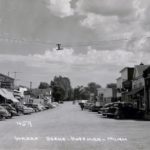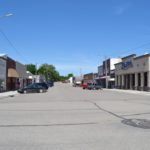Historical Pageant — Single Set — 8 Women, 7 Men, 4 Youth
Photos of Hoffman, Minnesota’s Main Street — 1909, 1940, 2016
Music By: Gary Rue
Commissioned By: The Hoffman Harvest Festival Committee; made possible by a generous grant from the Lake Region Arts Council
Description: A play with history that dramatizes how the community of Hoffman, MN originated and changed throughout its first 125 years.
Synopsis: Settlers homesteaded the Hoffman, MN area shortly after the end of the Civil War. When the government gave the Minneapolis and Pacific Railroad a grant, the company built a railroad from Minneapolis, MN to Lidgerwood, ND. The railroad founded towns every seven to ten miles along the tracks. Named after the chief engineer who designed the street layout, Hoffman officially became a town on June 23, 1891.
Hoffman grew into an important center for the area’s farmers. Its Main Street had hardware stores, barber shops, grocery stories, even a movie theatre. The town became home for three churches – Lands Lutheran Church (Norwegian), Bethel Lutheran Church (Swedish), and Zion Lutheran Church (German). Hoffman Public School opened on the end of Main Street. The town thrived as a social, educational, and commercial center throughout much of the 20th century.
Advances in agricultural technology caused many things to change in Hoffman. As less people were needed to farm the land, it became harder for area businesses to stay open. The schools had less children too, so eventually Hoffman’s school merged with other rural communities to form the West Central Area Schools. But new businesses are on Main Street, a wind farm spins just outside of town, and the grain elevator thrives. Hoffman continues to re-invent itself to become a new town of dreams.
Why It Was Written: When Hoffman’s school merged with Kensington’s school, I attended high school in Hoffman and became forever linked to the community. My dad frequented several Hoffman businesses for farm services and supplies too, so I spent summer days picking up stuff at the Hoffman Cenex Station or fixing machinery at the Hoffman Blacksmith Shop. When Muriel Krusemark, Hoffman’s Economic Development Director, asked if I wanted to write a play for Hoffman’s 125th anniversary, I immediately said yes.
I learned much interesting history about Hoffman. My favorite fact is that Hoffman is laid out in a T town design, with Main Street intersecting the railroad tracks to make a “T” shape. This placed all the businesses and grain elevators on one side of the tracks, so farmers would only need to cross the tracks once to get into town. The play dramatized how many businesses started and changed. And of course, the play highlighted people throughout Hoffman’s history — business leaders, school teachers, unique personalities….
I ended up directing this play too, so it turned into quite a project. We staged the production as a combination of Readers’ Theatre and staged scenes, which was a great way to incorporate both young and old actors in the same cast. Besides the large cast, we had a barbershop quartet, a 92 year-old-violinist, a church choir, and a cheerleading squad. We even had a closing theme song.
We Are Hoffman (Closing Song):
Read the first ten pages: Script Sample



